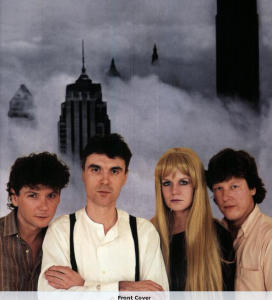 Have you read this book? It’s called “This Must Be The Place: The Adventures of Talking Heads in the 20th Century“, written by David Bowman and published in 2001.
Have you read this book? It’s called “This Must Be The Place: The Adventures of Talking Heads in the 20th Century“, written by David Bowman and published in 2001.
First off, I really like this band. A lot. Talking Heads took pop, punk, art, funk, and quirkiness and cooked up something unique and innovative, while at the same time catchy and infectious. No one else sounds like them. They pushed musical boundaries with nearly every song, but the music was so good it would be stuck in your head for weeks.
Now, on to this biography. The author has a casual style that is kind of fun but also can get kind of annoying. He refers to women as “chicks” (does anyone still do that?). And, while there are plenty of facts about the band and it’s members, there is also an obvious bias to his opinions. He gives a lot of time to the tensions between David and Tina, and places that as the reason the band quite working together. This may be true, there are quotes and insights from friends and others, but there could have been more contributions from the band members themselves. There are some nice photos in a center section, though I of course wanted more.
So the style wore on me a little, but I did learn much more about the band and it’s individual members, from the very beginnings of the group. I picked this book up used and I am glad I bought it. Was it a great bio? Maybe not. But if you like to know the story behind the music, then I would still recommend it. You’ll learn at least a little, maybe a lot, about the lives of David, Tina, Jerry, and Chris and what brought them together. And why they stopped being Talking Heads.
From amazon.com, here are a couple mini-reviews
From Publishers Weekly
Who better than a novelist-cum-music journalist to depict “a group that was completely of its time and totally outside of it”? From the Talking Heads’ individual roots to their electrifying collaboration and breakup, Bowman (Bunny Modern) portrays brilliant odd-bird David Byrne, even-keeled and Harvard-educated Jerry Harrison, happy-go-lucky Chris Frantz and enigmatic Tina Weymouth, who told Bowman: “I have to rewrite your book for you…. You know nothing about us.” Or maybe he knows more than she’d like? Bowman interviewed them (and 50 others) and studied their every mention e.g., New York Times writeups, Andy Warhol’s diary to understand how they got the nation singing “Psycho killer/ Qu’est que c’est/ fa fa fa…. ” While their dysfunctions intrigue, their unconventionality, hilarity and creative synergy fascinate. David, Chris and Tina met in art school in the 1970s and later shared a New York City loft. Months after Tina learned bass, the trio opened for the Ramones at CBGB, where a record exec pounced. Rounded out by Jerry’s keyboard, they shook underground and mainstream audiences, tempering curious lyrics about religion and politics with infectious melodies. They experimented with African polyrhythms and funk while maintaining New Wave followers. They split up in 1991 while “still sound[ing] like the Next New Thing.” Bowman’s funny, astute book tells how they pulled it off and why they pulled the plug. Bibliography, discography and filmography included; photos not seen by PW. (Apr.) Forecast: No other Talking Head-ography covers the breakup or beyond. Byrne’s forthcoming album will boost reader interest. Bowman’s cult-crit banter will appeal to New York music and art scene followers. – Copyright 2001 Cahners Business Information, Inc.
From Library Journal
A freelance music and culture journalist (New York Times Magazine, SPIN), Bowman here chronicles minimalist funk-rock band Talking Heads with their cooperation. He starts with character sketches of the quartet: the quiet, complex, blue-blooded bassist, Tina Weymouth; her artistic drummer-husband, Chris Frantz; the eccentric, nerdy, performance-artist-turned-singer David Byrne; and the Harvard-educated, ex-Modern Lover Jerry Harrison. Throughout, he places the band which formed at the Rhode Island School of Design in 1974 in the context of New York history and contrasts them with their Gotham art-punk contemporaries (e.g., Patti Smith, Television, and the Ramones). His deft analysis of how his subjects intersected with the avant-garde scene of Andy Warhol, composer Philip Glass, dancer Twyla Tharp, artist Jean-Michel Basquiat, and ambient Dadaist Brian Eno sets his work apart from Jerome Davis’s Talking Heads (1986. o.p.) and David Gans’s Talking Heads (1985. o.p.). Recommended for all popular music collections and indispensable for Talking Heads fanatics, as this is the only bona fide biography in print. Dave Szatmary, Univ. of Washington, Seattle – Copyright 2001 Reed Business Information, Inc.
Buy it here or shop for others
Talking Heads music that we own
